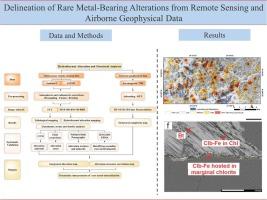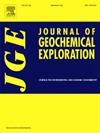Advanced exploration of rare metal mineralization through integrated remote sensing and geophysical analysis of structurally-controlled hydrothermal alterations
IF 3.4
2区 地球科学
Q1 GEOCHEMISTRY & GEOPHYSICS
引用次数: 0
Abstract
Fusing multi-source (remote sensing and geophysical) data and diverse approaches validation in targeting hydrothermal alteration and structural anomalies enhances the potential for accurately detecting and characterizing mineralization zones. Sentinel 2 data and ASTER were processed for lithological and hydrothermal alteration mapping in the rare metal-rich Umm Naggat area (Egypt). Different image processing techniques were implemented, including false color composites, minimum noise fraction, band rationing, band math, mineral indices, relative absorption band depth, and constrained energy minimization. The rare metal-bearing Umm Naggat younger granite (NYG) pluton was lithologically discriminated and intra-differentiated to mafic-rich biotite granites, mafic-poor alkali feldspar granites, and albitized granites. Extensive hydrothermal alterations, such as albitization, ferrugination, propylitization, argillization, and phyllitization, overprint the NYG pluton. Normalized standard deviation, automatic lineament extractions, and trend analysis highlighted the key structural directions (NW, NNW, NNE, and NE) and distinguished the NYG pluton as a moderate to high structural density zone. The high structural density and intensive alteration zones are spatially associated and more localized within the NYG pluton than the surrounding rocks. Spatial overlay analysis confirmed that the hydrothermal alterations and fluid circulation systems are structurally-controlled. Furthermore, the hydrothermal alteration mapping and structural analysis outcomes were verified by combining fieldwork, slab polishing, petrographic investigations, and mineral chemistry through semi-quantitative scanning electron microscopy with energy dispersive spectroscopy (SEM-EDS) and quantitative electron probe microanalysis (EPMA) analysis. As a result, the hydrothermal genesis of rare metal-bearing minerals (Nb-rutile, Nb-ilmenite, and columbite) close to or incorporated within alteration minerals (chlorite, muscovite, and hematite) is confirmed from the alteration zones (propylitic, phyllic, and ferruginated). In addition, biotite muscovitization and chloritization significantly contribute to the secondary rare metal enrichment. The current study emphasizes the extensive distribution of secondary rare metal-bearing minerals within the entire NYG pluton (not only limited to the northern albitized granite as depicted by previous studies), which might shed light on these hydrothermally-altered younger granites as a new potential source for Nb and Ta in Egypt.

通过对结构控制热液蚀变进行综合遥感和地球物理分析,对稀有金属矿化进行高级勘探
将多源(遥感和地球物理)数据与针对热液蚀变和构造异常的多种验证方法相结合,可提高准确探测和描述矿化区的潜力。对哨兵 2 号数据和 ASTER 进行了处理,以绘制稀有金属丰富的乌姆纳加特地区(埃及)的岩性和热液蚀变图。采用了不同的图像处理技术,包括假色合成、最小噪声分数、波段配比、波段数学、矿物指数、相对吸收波段深度和约束能量最小化。对含稀有金属的乌姆纳加特年轻花岗岩(NYG)岩体进行了岩性分辨,并将其内部分化为富含黑云母的生物花岗岩、黑云母贫碱长石花岗岩和白化花岗岩。广泛的热液蚀变,如白化、铁化、丙化、钝化和植物化,覆盖了 NYG 长岩。归一化标准偏差、自动线状提取和趋势分析突出了主要的构造方向(NW、NNW、NNE 和 NE),并将 NYG 长岩区分为中高构造密度区。与周围的岩石相比,NYG 长岩的高构造密度区和密集蚀变区在空间上是相关联的,并且更加局部化。空间叠加分析证实,热液蚀变和流体循环系统受构造控制。此外,通过半定量扫描电子显微镜与能量色散光谱分析(SEM-EDS)和定量电子探针显微分析(EPMA),结合实地考察、板坯抛光、岩相学调查和矿物化学分析,对热液蚀变绘图和结构分析结果进行了验证。结果,从蚀变带(丙铁化、辉绿岩化和铁锈化)证实了含稀有金属矿物(铌-金红石、铌-钛铁矿和铌铁矿)的热液成因,这些矿物靠近蚀变矿物(绿泥石、褐铁矿和赤铁矿)或与蚀变矿物(绿泥石、褐铁矿和赤铁矿)结合在一起。此外,黑云母化和绿泥石化也大大促进了次生稀有金属的富集。目前的研究强调了含次生稀有金属矿物在整个 NYG 长岩中的广泛分布(而不仅限于之前研究中描述的北部白化花岗岩),这可能会揭示这些经热液蚀变的较年轻花岗岩是埃及 Nb 和 Ta 的新潜在来源。
本文章由计算机程序翻译,如有差异,请以英文原文为准。
求助全文
约1分钟内获得全文
求助全文
来源期刊

Journal of Geochemical Exploration
地学-地球化学与地球物理
CiteScore
7.40
自引率
7.70%
发文量
148
审稿时长
8.1 months
期刊介绍:
Journal of Geochemical Exploration is mostly dedicated to publication of original studies in exploration and environmental geochemistry and related topics.
Contributions considered of prevalent interest for the journal include researches based on the application of innovative methods to:
define the genesis and the evolution of mineral deposits including transfer of elements in large-scale mineralized areas.
analyze complex systems at the boundaries between bio-geochemistry, metal transport and mineral accumulation.
evaluate effects of historical mining activities on the surface environment.
trace pollutant sources and define their fate and transport models in the near-surface and surface environments involving solid, fluid and aerial matrices.
assess and quantify natural and technogenic radioactivity in the environment.
determine geochemical anomalies and set baseline reference values using compositional data analysis, multivariate statistics and geo-spatial analysis.
assess the impacts of anthropogenic contamination on ecosystems and human health at local and regional scale to prioritize and classify risks through deterministic and stochastic approaches.
Papers dedicated to the presentation of newly developed methods in analytical geochemistry to be applied in the field or in laboratory are also within the topics of interest for the journal.
 求助内容:
求助内容: 应助结果提醒方式:
应助结果提醒方式:


